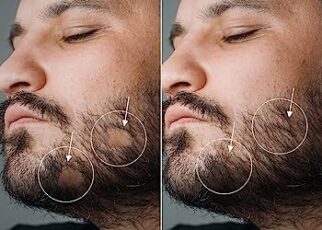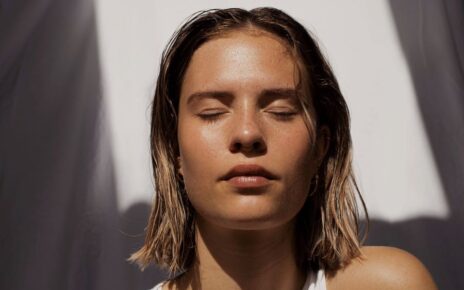Minoxidil for beard – At some stage in our lives, numerous individuals may encounter difficulties with beard growth. These issues can manifest as patchy growth due to ageing or dissatisfaction with the inherent thickness of our beard.
Consequently, many individuals seek remedies for their beard growth concerns, exploring options ranging from lotions and oils to transplants. In today’s market, there is a wide array of products specifically designed to promote beard growth, and one such solution that garners attention is minoxidil.
But what exactly is minoxidil, and does it effectively stimulate beard growth? Our latest article delves into these inquiries and provides comprehensive answers. Let us commence our exploration.
What is minoxidil?
Minoxidil is a medication primarily utilized to address hair loss concerns. It is also marketed under the brand name Regaine and is obtainable with a prescription and over the counter. Its purpose is to combat hair loss and facilitate hair regrowth.
Initially intended for treating high blood pressure, minoxidil has now found its main application in addressing hair loss among women and men. While its primary licensed usage revolves around treating hair thinning and baldness on the scalp, there has been a growing trend of off-label use to promote beard growth.
Minoxidil is available in three different forms: a solution, a foam, and an oral tablet.
Can Minoxidil Grow Beard?
Typically, minoxidil is applied to the scalp to assist with hair loss. However, when utilizing minoxidil for promoting beard growth, it is specifically applied to the lower face, chin, and neck regions.
The precise mechanism by which minoxidil stimulates hair growth remains unclear. It has been observed that when minoxidil is applied to the hair, it appears to enhance the size and strength of hair follicles, thereby supporting hair growth during its active growth phase, known as the anagen phase.
Although minoxidil has demonstrated effectiveness for promoting hair growth on the scalp, it is important to acknowledge that limited evidence supports its benefits for beard growth.
Only a single study has been conducted to explore using minoxidil specifically for beard growth. This study observed a slightly higher success rate with minoxidil lotion compared to a placebo (approximately 3%). However, these findings are considered relatively insignificant and do not establish conclusive evidence regarding the efficacy of minoxidil for promoting beard growth.
While some individuals opt for minoxidil as a potential solution for enhancing beard growth, it is crucial to recognize that its effectiveness lacks definitive proof.
How to use minoxidil for beard growth?
Incorporating a minoxidil-infused product into your daily routine requires only a few seconds of your time. After cleansing your face, apply the minoxidil-containing product onto slightly damp beard skin—avoiding excessive wetness, as products absorb better into damp skin.
Gently massage the product into the desired areas where you seek thicker and denser hair. Once applied, remember to wash your hands and proceed with the rest of your skincare regimen, ensuring that you avoid spreading the product onto other areas of your face (unless you desire an unintended resemblance to an amateur rendition of Teen Wolf…just kidding!).
While the temptation to use it more frequently may arise in hopes of hastening hair growth, it is advisable to adhere to the twice-a-day instructions recommended by most brands and allow the product to work its magic.
How Long Does Minoxidil Take For Beard Growth?
If you’re interested in exploring minoxidil for beard growth, it is important to note that there is limited substantiating evidence regarding its effectiveness in stimulating beard growth.
However, if you decide to use minoxidil on your beard, research suggests that a small amount twice a day is recommended. It is advised to continue this regimen for at least 16 weeks or until visible results become apparent.
To track any potential changes in your beard, it might be beneficial to capture before and after photos, allowing you to observe and assess any noticeable differences.
How long do results of minoxidil beard growth last?
When utilized for the scalp, minoxidil typically begins to show results within 4-8 weeks. However, it may require an extended period to witness the full effects of minoxidil on hair growth, often taking 4-6 months of consistent usage to notice noticeable changes. You might experience mild hair shedding during this time, eventually replaced by stronger hair strands.
For individuals seeking to employ minoxidil for beard growth, if it proves effective, visible results can be expected within 4-6 months of continuous use (based on its efficacy for scalp hair). It is worth noting that initial light shedding from the beard is possible before the hair regrows thicker and stronger.
Regarding the long-term effectiveness of minoxidil, results typically persist as long as the product is used consistently. However, a study focused on topical minoxidil solution for androgenetic alopecia (male pattern baldness) indicated that the results appeared to peak at approximately 12 months.
Is It Safe To use Minoxidil for beard growth?
While minoxidil is officially approved solely for beard growth purposes, it is also considered safe for beard growth, despite the lack of confirmed effectiveness.
Nevertheless, like any medication, there are potential side effects that you may encounter when using minoxidil for beard growth. These side effects can encompass:
- Dry skin
- Scaly texture on the skin
- Weight gain
- Dizziness
- Redness or irritation in the application area
- Hair experiencing changes in color or texture
In most cases, these side effects should diminish as your body adapts to the minoxidil. However, if they persist or worsen, you should consult your general practitioner for further guidance.
Alternatives
Since minoxidil lacks conclusive evidence for its effectiveness for promoting beard growth, it is advisable to explore alternative options. Here are a few alternatives worth considering:
- Neoxyl: Neoxyl is a popular alternative medication that targets hair growth. It shares similarities with minoxidil but is a water-based solution that does not contain solvents like propylene glycol (PPG).
- Peppermint oil: Peppermint oil is a natural alternative to minoxidil for beard growth. Some evidence suggests that applying peppermint oil to the beard area can help stimulate hair growth in that region.
- Acupuncture: While limited evidence exists, some individuals use acupuncture to stimulate blood flow around hair follicles and promote beard growth.
- Lifestyle changes: Maintaining a healthy diet and reducing stress levels can contribute to healthier beard growth. For more information on this topic, visit our blog post addressing patchy beards.
- Beard transplant: If you prefer a surgically supported solution for beard growth instead of minoxidil, you may want to consider a beard transplant. This safe surgical procedure offers permanent results and allows you to choose your desired beard style and growth area. Typically, only one operation is necessary.
Exploring these alternatives and consulting with a healthcare professional or specialist is recommended to determine the most suitable option for your specific needs and preferences.
FAQs:
Certainly! Here are some frequently asked questions (FAQs) regarding minoxidil and beard growth:
- Is minoxidil FDA-approved for beard growth?
- No, minoxidil is not specifically approved by the FDA for beard growth. Its primary approval is for hair regrowth on the scalp.
- Can minoxidil be used for patchy beard growth?
- While minoxidil is often used off-label for patchy beard growth, its effectiveness is not definitively established.
- How long does it take for minoxidil to work on the beard?
- The timeline for minoxidil to show visible results on the beard varies. Some users may notice changes within a few months, while others may require several months of consistent use.
- Are there any side effects associated with using minoxidil on the beard?
- Possible side effects of minoxidil on the beard can include dry skin, irritation, and changes in hair texture. However, these effects are generally temporary and tend to diminish over time.
- Can minoxidil cause facial hair to grow in areas other than the beard?
- Minoxidil can potentially promote hair growth in unintended areas, so it’s important to apply it only to the desired beard areas and avoid spreading it to other facial regions.
- Is minoxidil safe to use for beard growth?
- Minoxidil is generally considered safe for topical use, including for beard growth. However, consulting with a healthcare professional before starting any new treatment is recommended to ensure it aligns with your specific health circumstances.
Discover more from Thenewsdoor
Subscribe to get the latest posts sent to your email.





